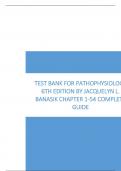TEST BANK FOR PATHOPHYSIOLOG
6TH EDITION BY JACQUELYN L.
BANASIK CHAPTER 1-54 COMPLET
GUIDE
,Chapter 1: Introduction to Pathophysiology
Test Bank
MULTIPLE CHOICE
1. C.Q. was recently exposed to group A hemolytic Streptococcus and subsequently developed a pharyng
examination reveals an oral temperature of 102.3° F, skin rash, dysphagia, and reddened throat mucosa
complains of sore throat, malaise, and joint stiffness. A throat culture is positive for Streptococcus, and
prescribed. The etiology of C.Q.’s disease is
a. a sore throat.
b. streptococcal infection.
c. genetic susceptibility.
d. pharyngitis.
ANS: B
Etiology refers to the proposed cause or causes of a particular disease process. A sore throat is the man
process. Genetic susceptibility refers to inherited tendency to develop a disease. Pharyngitis refers to in
is also a clinical manifestation of the disease process.
REF: Pg. 2
2. A 17-year-old college-bound student receives a vaccine against an organism that causes meningitis. Th
a. primary prevention.
b. secondary prevention.
c. tertiary prevention.
d. disease treatment.
ANS: A
Primary prevention is prevention of disease by altering susceptibility or reducing exposure for suscepti
vaccination. Secondary prevention is the early detection, screening, and management of the disease. Te
rehabilitative and supportive care and attempts to alleviate disability and restore effective functioning.
management of the disease once it has developed.
REF: Pg. 9
3. An obese but otherwise healthy teen is given a prescription for a low-calorie diet and exercise program
a. primary prevention.
b. secondary prevention.
c. tertiary prevention.
d. disease treatment.
ANS: B
Secondary prevention is the early detection, screening, and management of the disease such as prescrib
individual who has already developed obesity. Primary prevention is prevention of disease by altering
exposure for susceptible individuals. Tertiary prevention includes rehabilitative and supportive care an
disability and restore effective functioning. Disease treatment involves management of the disease onc
REF: Pgs. 9-10
4. A patient with high blood pressure who is otherwise healthy is counseled to restrict sodium intake. Thi
a. primary prevention.
b. secondary prevention.
c. tertiary prevention.
d. disease treatment.
ANS: B
Secondary prevention is the early detection, screening, and management of the disease, such as by pres
high blood pressure. Primary prevention is prevention of disease by altering susceptibility or reducing
, 6. A patient has been exposed to meningococcal meningitis, but is not yet demonstrating signs of this dise
called the _____ stage.
a. prodromal
b. latent
c. sequela
d. convalescence
ANS: B
Incubation refers to the interval between exposure of a tissue to an injurious agent and the first appeara
In infectious diseases, this period is often called the incubation (latent) period. Prodromal refers to the
and symptoms indicating the onset of a disease. These are often nonspecific, such as headache, malaise
which are associated with a number of different diseases. Sequela refers to subsequent pathologic cond
disease. Convalescence is the stage of recovery after a disease, injury, or surgical operation.
REF: Pg. 3
7. A disease that is native to a particular region is called
a. epidemic.
b. endemic.
c. pandemic.
d. ethnographic.
ANS: B
A disease that is native to a particular region is called endemic. An epidemic is a disease that spreads to
same time. Pandemics are epidemics that affect large geographic regions, perhaps spreading worldwide
REF: Pg. 6
8. In general, with aging, organ size and function
a. increase.
b. decrease.
c. remain the same.
d. is unknown.
ANS: B
In general, with aging, organ size and function decrease.
REF: Pg. 5
9. The stage during which the patient functions normally, although the disease processes are well establis
a. latent.
b. subclinical.
c. prodromal.
d. convalescence.
ANS: B
The stage during which the patient functions normally, although the disease processes are well establis
stage. The interval between exposure of a tissue to an injurious agent and the first appearance of signs
a latent period or, in the case of infectious diseases, an incubation period. The prodromal period, or pro
appearance of the first signs and symptoms indicating the onset of a disease. Convalescence is the stag
injury, or surgical operation.
REF: Pg. 3
MULTIPLE RESPONSE
10. Your patient’s red blood cell is slightly elevated today. This might be explained by (Select all that appl
a. gender difference.
b. situational factors.
, COMPLETION
12. When the cause is unknown, a condition is said to be ________.
ANS:
idiopathic
Many diseases are idiopathic in nature.
REF: Pg. 2
13. The nurse is swabbing a patient’s throat to test for streptococcal pharyngitis. The nurse must understan
in the probability that they will be positive for a condition when applied to a person with the condition;
________.
ANS:
sensitivity
The sensitivity of any test refers to the probability that the test will be positive when applied to a perso
not provide a false negative result. In contrast, specificity is the probability that a test will be negative w
does not have a given condition.
REF: Pg. 5




